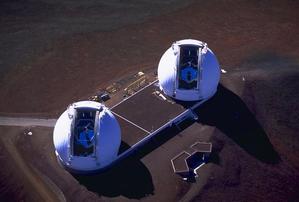Glossarbegriffe: Optische Astronomie
Description: Die optische Astronomie befasst sich mit der Untersuchung und Beobachtung des Universums (Sterne, Planeten, Zwergplaneten, Asteroiden usw.) im nahen Infrarot, im sichtbaren Licht und im ultravioletten Licht. Diese drei Arten von elektromagnetischer Strahlung werden zusammengefasst, weil optische Teleskope mit Glaslinsen und/oder Metallspiegeln, die ursprünglich für Beobachtungen im sichtbaren Licht gebaut worden sind, ebenso gut für die Beobachtung des nahen Infrarots oder des ultravioletten Lichts geeignet sind. Außerdem ist die Erdatmosphäre nicht nur für das sichtbare Licht, sondern auch für die direkt angrenzenden infraroten und ultravioletten Bereiche transparent, sodass alle drei Arten von Beobachtungen vom Boden aus möglich sind. Nicht zuletzt können die Kamerachips, welche Astronomen für Beobachtungen im sichtbaren Licht verwenden, auch Nahinfrarot- und Ultraviolettlicht erkennen. All dies zusammengenommen bedeutet, dass die Teleskope und Instrumente, die Astronomen für die Beobachtung des sichtbaren Lichts verwenden, ebenso gut für Beobachtungen im nahen Infrarot und im Ultraviolett geeignet sind. Daher ist es sinnvoll, Beobachtungen in diesem Bereich des elektromagnetischen Spektrums mit einem einzigen Begriff zu beschreiben, nämlich dem der optischen Astronomie. Das Adjektiv "optisch" wird auch verwendet, um den Spektralbereich zu beschreiben, wie in "der optische Teil des Spektrums". Beobachtungen in diesem Bereich sind "optische Beobachtungen".
Zugehörige Glossarbegriffe:
See this term in other languages
Term and definition status: The original definition of this term in English have been approved by a research astronomer and a teacher The translation of this term and its definition is still awaiting approval
The OAE Multilingual Glossary is a project of the IAU Office of Astronomy for Education (OAE) in collaboration with the IAU Office of Astronomy Outreach (OAO). The terms and definitions were chosen, written and reviewed by a collective effort from the OAE, the OAE Centers and Nodes, the OAE National Astronomy Education Coordinators (NAECs) and other volunteers. You can find a full list of credits here. All glossary terms and their definitions are released under a Creative Commons CC BY-4.0 license and should be credited to "IAU OAE".
Zugehörige Medien
Hubble Space Telescope over Earth
Bildnachweis: NASA/ESA credit link
License: CC-BY-4.0 Creative Commons Namensnennung 4.0 International (CC BY 4.0) icons
Keck Telescopes
Bildnachweis: NASA/JPL credit link
License: PD Public Domain icons










